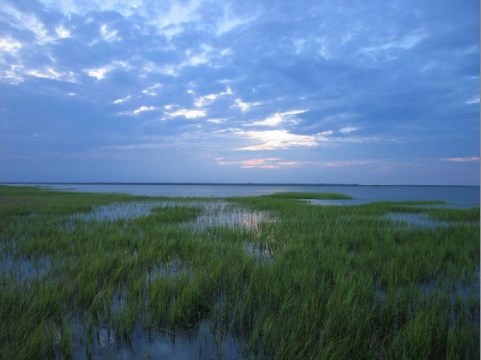
Georgia: Researchers say lush, essential vegetation fading because of climate change. Georgia’s salt marshes cover more than 400 square miles of the coast, an area about the size of Chatham County. These lush expanses of Spartina nurture commercial fisheries, boost the value of adjacent property and generally provide a balm for the souls of people who live, work and play around them.
Drive out to Tybee or down Interstate 95 and they seem as healthy as when 19th century poet Sidney Lanier exulted how they “stretch leisurely off, in a pleasant plain.” The problem is, they’re not as healthy as they were even 30 years ago.
A new study published in the journal Remote Sensing concludes that the amount of vegetation near Sapelo Island has declined by more than a third in that time. Climate change is likely driving the decline.
The 35 percent loss of marsh plant biomass surprised even those most familiar with the area, like co-author John Schalles, who has been researching Sapelo’s marshes for nearly 20 years. There was no die-off, he said. The change is subtler.
“It’s really like the plants went on a diet,” said Schalles, a professor of biology at Creighton University and an adjunct professor of marine science at the University of Georgia. “They’re not as robust.”
The study links the declining productivity to prolonged periods of drought and increased temperatures, two factors also linked to climate change. Researchers tracked Sapelo’s marshes over a 28-year period by examining images from NASA’s Landsat TM 5 satellite, which passed over the area every 16 days before its demise in late 2011.
They weeded out days when cloud cover obscured the view or the tide was too high and still had a treasure trove of nearly 300 images. Researcher John O’Donnell pinpointed the same study areas on each image to track the growth of marsh grass over time on plots of about 1,000 square feet, about the size of a typical house’s foundation.
By measuring the biomass at numerous smaller sites behind Sapelo — a painstaking process that involves clipping off all the Spartina at the base, drying it in an oven and weighing it — they developed a model that calculates biomass from the colors shown in the satellite imagery. O’Donnell is a graduate student in Creighton’s department of atmospheric sciences.
The scope of the work would have been impossible if not for the satellite. The marsh is just too difficult to slog through and measure on this scale.
“An ecologist could never do that in their lifetime,” Schalles said.
The salt marsh’s productivity is legendary, equaled only by tropical rainforests. Less Spartina, which makes up about 98 percent of the marsh cover, forces repercussions up the food chain.




